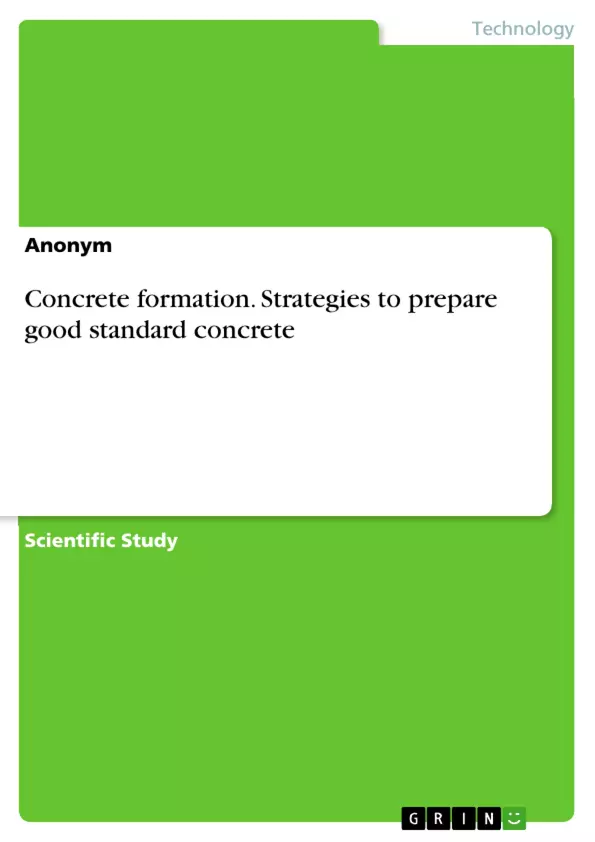This article provides information regarding formation of concrete. Portland cement is produced by combining calcium silicates, aluminates, and aluminoferrite. Clinker is made by mixing together minute quantities of limestone, clay, and other minerals. Cement that is older than three months ought to first be put through a series of strength examinations before being put to any practical use at all. Portland Pozzolana Cement (PPC) is obtained in one of two ways. It can be made by intergrinding a pozzolanic material with clinker and gypsum. The amount of time it takes for the concrete to set can be accelerated or slowed down depending on the salts, chemicals, clay, and other elements mixed inadvertently with the sand, aggregate, and water. Aggregates, before being used, should go through the required screening procedure and, if necessary, be cleaned by washing. It is crucial to keep in mind that fine aggregates must be free of coagulated lumps. Increasing the water-to-cement ratio leads to a reduction in the compressive strength of concrete. Mixing water should not contain any substances that have the potential to have a significant negative effect on the strength (i.e., on the process of hydration) or durability of the concrete. Water that is safe for consumption can also be used for mixing without requiring any major adjustments. High alumina cement contains more alumina than ordinary Portland cement. Water that contains free carbonic acid is water that should not be used in the manufacturing of concrete. The quality of concrete suffers when it is mixed with water that has a sulphate concentration greater than 1%.
Inhaltsverzeichnis (Table of Contents)
- CEMENT
- OPC
- ADVANTAGES OF USING PORTLAND POZZOLANA CEMENT OVER
- SETTLING OF CEMENT
- THE RETRIEVAL AND STORAGE OF CEMENT
Zielsetzung und Themenschwerpunkte (Objectives and Key Themes)
This article aims to provide comprehensive information regarding the formation of concrete, highlighting key aspects like the composition of Portland cement, the role of aggregates, and the factors influencing the setting and storage of cement.
- The composition and properties of Portland cement
- The importance of aggregate quality and preparation
- Factors influencing the setting time of concrete
- Best practices for the retrieval and storage of cement
- Advantages and disadvantages of different types of cement
Zusammenfassung der Kapitel (Chapter Summaries)
CEMENT
This chapter delves into the fundamental composition of Portland cement, explaining the roles of calcium silicates, aluminates, and aluminoferrite. It describes the clinker manufacturing process, including the mixing of limestone, clay, and other minerals, followed by high-temperature heating and pulverization. The chapter also discusses the classification of Ordinary Portland Cement (OPC) based on compressive strength and the importance of regular strength examinations for cement older than three months.
OPC
This chapter compares the advantages of Portland Pozzolana Cement (PPC) over OPC. It highlights the benefits of pozzolana, which combines with lime and alkali to enhance strength, impermeability, and resistance to sulfates. PPC also contributes to better workability, reduced bleeding, and control over thermal expansion. The chapter emphasizes that the color of PPC, often influenced by the pozzolanic material, does not necessarily reflect its quality.
SETTLING OF CEMENT
This chapter explores the setting process of cement, explaining how the paste transitions from a pliable state to a solid form. It discusses the factors influencing setting time, including the type of cement, environmental conditions, and the presence of impurities in the mixing water.
Schlüsselwörter (Keywords)
The article focuses on concrete formation, Portland cement, clinker, OPC, PPC, aggregates, setting time, retrieval, storage, and quality control.
- Citar trabajo
- Anonym (Autor), 2022, Concrete formation. Strategies to prepare good standard concrete, Múnich, GRIN Verlag, https://www.grin.com/document/1286517



